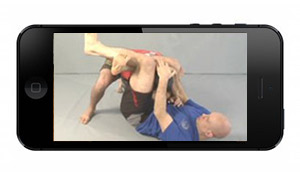Have you ever wondered what the most popular and powerful BJJ submissions in BJJ are? Here’s our list of the top 37 submissions taught in BJJ academies all over the world.
WARNING: not all of these techniques are legal in IBJJF competition, or allowed at all schools. But it’s still better to be familiar with these illegal techniques just in case someone tries to use them on you. And many of these illegal BJJ moves still have a ton of validity for MMA applications or self defense situations, so they are well worth learning!
1. Rear Naked Choke (aka RNC, Mata Leão, Lion Killer or Sleeper Hold)
The Rear Naked Choke is the single most important submission in Brazilian Jiu-Jitsu. This is the definitive way to end a fight, and should be your primary threat anytime you have the rear mount.
No matter if you’re doing BJJ with the gi, no gi submission grappling, MMA or self defense, sink this choke and the fight should be over!
2. Straight Armbar
The straight armbar is one of the most versatile and powerful submissions in BJJ. It can be applied from just about any position, including the mount, sidemount, rear mount, kneemount, against the turtle or from the guard.
Below is a very easy way to learn the armbar from the guard, and you can click here for the most common mistakes for the armbar from top or here for the most common armbar from guard mistakes.
3. Triangle Choke
The Triangle Choke is a BJJ signature move and it has finished a huge number of matches and sparring sessions. It is one of the most common BJJ submissions from the guard, but you can also set it up from other positions. And there are other variations of the triangle choke where you apply it from the back, the side, and other angles.
The Triangle Choke can be a finicky submission, and it can take a while to become comfortable with the fine details that make this technique so powerful. But if you have long, flexible legs then this might just be your move!
4. Bow and Arrow Choke
This might be the single most powerful gi choke in BJJ. You get your grip on your opponent’s lapel, and then use your other arm to rotate your body relative to his which tightens the choke considerably. This is a very popular choke in high level competition and for smaller sized grapplers.
Typically you will apply the Bow and Arrow Choke from rear mount, but there are also other entries for this submission, including, for example, rolling attacks vs. the turtle position.
5. Americana Armlock (aka V Armlock, Ude Garami)
The Americana is usually one of the first submissions you learn in BJJ, and is a twisting submission that mostly attacks the shoulder joint.
The Americana is most often applied from sidemount, but you can also apply it from mount, kesa gatame, or even from guard (a variation known as the ‘Frank Mir lock’).
6. Sleeve Choke (aka Ezekiel Choke)
The Sleeve Choke is a very versatile attack that can be launched from almost any position, including positions where you ordinarily wouldn’t have many submission attacks (e.g. the bottom of mount, inside your opponent’s guard, etc.).
Once you’ve wrapped your arm arm around your opponent’s head then all you need to do is connect your two arms together by grabbing inside your own sleeve and – BOOM – the choke is on!
7. Guillotine
The Guillotine is a fundamental submission that is most often applied from the closed guard or from standing. There are many variations of the Guillotine, including the 10 Finger Guillotine, the Marcelotine, and the Arm- in Guillotine.
8. Kimura Armlock (aka Figure 4 armlock, Chicken Wing)
The Kimura is a powerful bent armlock that forces your opponent’s arm behind his back stressing the shoulder and elbow joint. It is most often applied from guard and sidemount.
The Kimura is named after the famous judoka Masahiko Kimura who used it to defeat Helio Gracie during a grappling match in 1951.
9. Cross Collar Choke (aka X Choke)
The Cross Collar Choke is a classic BJJ submission that can be applied whenever you’re facing an opponent, typically from the mount or guard position.
This choke typically requires at least one hand to be deep in the opponent’s lapel. There are variations of this choke where you have i) both palms facing you, ii) both palms facing away from you, and iii) one palm facing you and the other turned away.
10. Straight Ankle Lock (aka Achilles Lock, Straight Foot Lock)
The Straight Ankle Lock is one of the most common, most fundamental leglocks. In it you control your opponent’s leg with your own legs, and then apply pressure to his foot and ankle using your arms.
The Straight Ankle Lock forces your opponent to submit through two main pressures: i) hyperextension of muscles and ligaments on the top of the foot, and ii) compression of the Achilles tendon at the back of the leg. This technique is the foundation for many other leglocks (like heel hooks, toeholds, steering wheels, etc) because it teaches you how to control the movement of your opponent’s leg using a relatively safe leglock attack.
11. Short Choke (aka Hadaka Jime)
If you’re behind your opponent then you don’t necessarily need to apply the full Rear Naked Choke. Sometimes it’s enough to just get your forearm across the throat in the Short Choke position, and then lever your arm into the windpipe to obtain a quick submission!
12. Baseball Choke
The Baseball Choke uses two lapel grips (typically from kneemount) to apply a very effective choke used by many high-level players.
This technique complements the X Choke very well. In the X Choke you grip the lapels with your arms crossed. In the Baseball Choke you grip the lapels with your arms uncrossed. Either way, you end up with a powerful choke and a tapping opponent!
13. Kneebar
The kneebar is one of those submissions in BJJ where you use the power of your entire body against a single joint of your opponent. You clamp down tight on his leg, control the ability of his body to rotate, and then extend your hips for the submission!
You can apply the kneebar from top, bottom, or even from standing. It is a very versatile submission.
14. D’Arce Choke (aka No Gi Brabo Choke)
The D’Arce Choke is named after Joe D’Arce, the BJJ competitor who popularised it.
It is most often used when you’re in sidemount or half guard top. To apply the choke you triangle your arms around both his neck and his undercooking arm, then bring on the pressure to apply the choke and finish the match.
15. Biceps Slicer
The Bicep Slicer is a tricky, unexpected submission that is illegal in most tournaments until black belt level. That’s because when this move is applied at full force (or when an opponent chooses to suffer through the pain and doesn’t tap) you can break the radius bone in your opponent’s forearm. Use this attack carefully, and just let your your training partners go if they’re stupid, stubborn, or just don’t tap out.
16. Omoplata
The Omoplata is an attack with a million setups, finishes and variations. Typically this BJJ submission is applied from the guard, and forces your opponent’s arm into a Kimura-like position using your legs instead of your arms.
The omoplata can tap your opponent out, but you depending on his reaction you can also sweep him and get to the top, or transition into many other submission attacks.
17. Clock Choke
The Clock Choke against the turtle position is a classic attack that you find both in Jiu-Jitsu and in Judo.
In an effective Clock Choke you first get a grip on the far collar with your wrist going across your opponent’s throat. Then you use your body to pin your opponent and to generate pressure on the neck to obtain the submission.
18. Calf Crusher (aka Knee Slicer)
The Calf Crusher is very similar to the Bicep Slicer lock, just applied on your opponent’s leg rather than his arm. Like the Bicep Slicer it is also illegal in most gi tournaments until the black belt level. The Calf Crush transitions nicely to rear mount if for some reason you just can’t finish the submission.
19. Figure 4 Toehold
The Figure 4 Toehold is a very versatile leglock that can be applied any time you get near your opponent’s foot.
It can be used as a primary attack, or as a followup to other leglocks. The action of this leglock is somewhat similar to the heel hook, but for some reason it is a legal technique in a much wider assortment of tournaments than other rotational leglocks.
20. Wristlock (aka Cow Hand, Mão de Vaca)
The wristlock is an unexpected, but effective, attack that can be applied from a great number of positions. There are four main ways to lock the wrist, including compression, extension, inward and outward rotation.
The wrist is a very delicate joint; it is easily damaged and takes a very long time to heal. Be careful with this attack, always applying it slowly to give your opponent or training partner lots of time to tap out.
21. Head and Arm Choke (aka Side Choke, Kata Gatame)
The Head and Arm Choke is a classic BJJ submission that comes from Judo (where it is known as Kata Gatame). It is most often applied from side mount or full mount, but you also see it being used from the closed guard occasionally.
22. North-South Choke
The North South Choke uses your arm and the weight of your body to apply pressure to your opponent’s neck when you’re in the north-south position. It can be a slow choke to apply, but it is very effective and several world class grapplers have made it one of their primary attacks.
23. Heel Hook
The Heel Hook is a very effective BJJ submission, but it is also highly illegal in most tournaments. Because it is a rotational leglock there is very little time between your opponent starting to feel the pain and the damage occurring, especially when adrenaline is flowing. BJJ practitioners should still be familiar with the Heel Hook for self defense applications and also to recognise the submission if someone tries to apply it on them.
If you use the heel hook in training go super-duper light and never-ever apply it fully. Practice catch-and-release training or you WILL destroy the cruciate ligaments of your training partner’s knee.
24. Reverse Heel Hook
The only thing worse than a regular Heel Hook is the Reverse Heel Hook. In this submission the leg is rotated outwards instead of inwards, which brings the submission on even quicker. Everything I said about training the Heel Hook safely applies double to this submission!!
25. Crucifix Choke
The Crucifix is a position in which you’re behind your opponent trapping one of his arms with your legs, leaving your arms free to attack his neck. The video below shows one way of securing the position and attacking the neck, but you can also use a short choke/armbar combination from this same position that works both with and without the gi.
26. Thrust Choke
The Thrust Choke is an old-school attack using your opponent’s lapels to choke him out. Often this is done from the mount position, but play the video below and you’ll learn how to do it from inside your opponent’s guard (starting at about the 5 minute mark).
27. Anaconda Choke
The Anaconda Choke is a rolling attack applied against the turtle position. It is similar to a Head and Arm Choke in the sense that you are trapping both your opponent’s head and one arm to apply the pressure, but the final body position is very different.
28. Neck Crank (aka Cervical Choke, Can Opener)
The Neck Crank is another technique that is illegal in almost all jiu-jitsu and submission wrestling tournaments, but very useful in MMA and self defence. In most neck cranks you force your opponent’s chin towards his chest, and/or force the neck to rotate while you hold his body in place.
In the Can Opener variation of the neck crank (shown in the video below) you use the Neck Crank from inside the guard. This is common in MMA, because even if it doesn’t work then it’s still a great way to open the guard to pass or create striking opportunities.
29. Twister
The Twister is a rotational neck and spine lock that was popularised by Eddie Bravo. It is illegal in most IBJJ tournaments, but it’s still a very fun move to practice in the dojo so long as you apply it slowly and gradually, giving your training partner lots of time to tap out!
30. Peruvian Necktie (Tony de Souza Choke)
The Peruvian Necktie is a variation of the Guillotine Choke popularised by MMA fighter and BJJ competitor Tony de Souza. In it you throw your legs over the shoulders and upper back of your opponent, which greatly amplifies the power of the choke and makes it possible to finish your Guillotine even if you have relatively weak arms.
31. Loop Choke
The Loop Choke is one of those surprise attacks from the guard that makes people want to burn their gi when they get caught in it. To apply this choke you get one grip on the collar, stuff his head under your armpit as he pressures forward, and then use a variety of grips and leg positions to finish the actual submission.
32. Banana Split Hiplock (aka Groin Stretcher, Crotch Ripper, Electric Chair)
The Banana Split Hiplock is one of the few effective leglocks that attacks the hips and groin area, and it sets up a variety of other moves and submissions including calf slicers, foot locks and taking the back.
The Electric Chair variation is very similar but uses the figure 4 lockdown leg position to control one leg while your arms stretch out his other leg.
33. Inverse Armbar (aka Reverse Armbar, Armcrush, Ude Gatame)
When you apply the Inverse Armbar you trap your opponent’s wrist between your head and shoulder, and then apply pressure down onto his elbow using your arms. This submission is typically applied from guard or kneemount, but it can also be used as a followup for a triangle choke that’s just not quite working.
34. Papercutter Choke
The Papercutter Choke is a classic gi-based submission from sidemount. To apply this choke you remove the slack from your opponent’s collar with one hand, and then cut down across the throat in a ‘paper cutter’ motion with the other hand.
35. Gogoplata
The Gogoplata is a variation of the Omoplata for flexible people! To apply it you weave the foot of the leg that traps your opponent’s arm in front of his throat, then force the foot into the throat to apply the choke.
36. Marceloplata
The Marceloplata – named after BJJ phenomenon Marcelo Garcia – is essentially an Omoplata where your legs are positioned in front of your opponent’s face and body. You can apply this submission from mount, but it can also can occur when you go for a regular Omoplata and he traps one underneath his body. Either way, once you secure the Marceloplata all it takes is a slight hip adjustment to finalise the lock and tap your opponent out.
37. Baratoplata
The Baratoplata is named after BJJ black belt Rafael Barato. It uses the power of the legs and hips to apply a Kimura-like attack on your opponent’s arm. It can be applied from a number of different positions but is most commonly first taught as a followup to a Triangle Choke where your opponent is attempting to weave his trapped arm out from between your legs.
Well, that’s our list of the top 37 submissions in BJJ!
Did we miss one of your favourites? Is there a submission that you think should have been included in this list? Say so in the comments below, and include a link to a Youtube video if possible!
Thanks,
Stephan Kesting
Grapplearts.com
Ready to brush up on your submissions? Here are some of our most popular instructional items…
This app for iOS, Android and Kindle provides you with a complete BJJ gameplan. You’ll get an entire positional strategy and get all the pieces you need to learn BJJ as fast as possible.
This module in the free Grapplearts BJJ Master App features 42 techniques broken down using video instruction into easy-to-follow steps, with advanced details, tricks and tips for every submission.
Stephan Kesting’s highly influential breakdown of the leglock game, including the straight ankle lock, toehold, heel hook and kneebar. Drills and training methods to stay safe are included in both DVDs.
The post 37 Powerful BJJ Submissions for Grapplers appeared first on Grapplearts.



